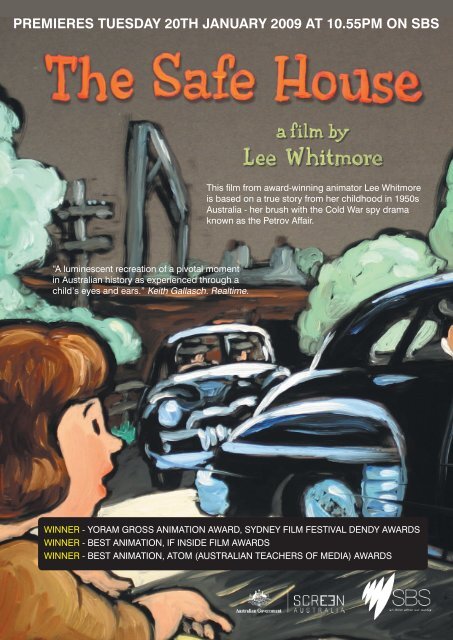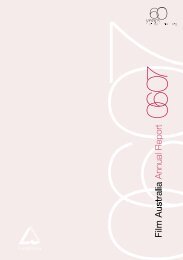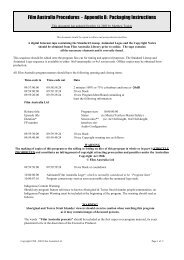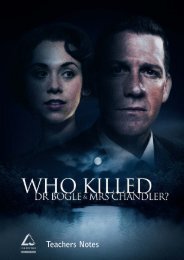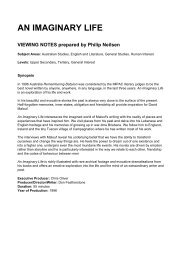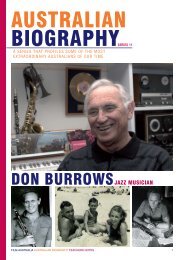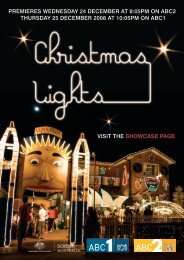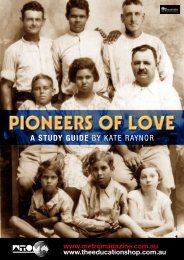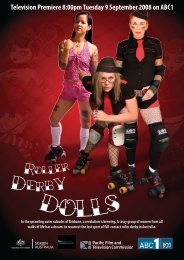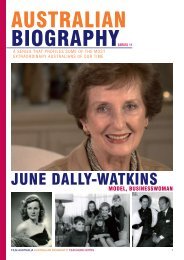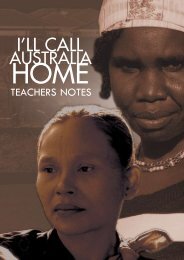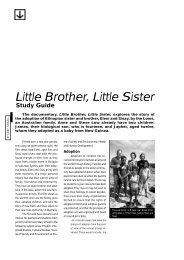The Safe House Press Kit
The Safe House Press Kit
The Safe House Press Kit
Create successful ePaper yourself
Turn your PDF publications into a flip-book with our unique Google optimized e-Paper software.
Premieres Tuesday 20th January 2009 at 10.55pm on SBS<br />
This film from award-winning animator Lee Whitmore<br />
is based on a true story from her childhood in 1950s<br />
Australia - her brush with the Cold War spy drama<br />
known as the Petrov Affair.<br />
“A luminescent recreation of a pivotal moment<br />
in Australian history as experienced through a<br />
child’s eyes and ears.” Keith Gallasch. Realtime.<br />
Winner - Yoram Gross Animation Award, Sydney Film Festival Dendy Awards<br />
Winner - Best Animation, IF Inside Film Awards<br />
Winner - Best Animation, ATOM (Australian Teachers of Media) Awards
Key Credits<br />
Animator/Writer/Director: LEE WHITMORE<br />
Producer: DENISE HASLEM<br />
Featuring the voices of:<br />
NONI HAZLEHURST as adult Lee Whitmore<br />
TARA MORICE as Val Whitmore<br />
GENNARDI DUBINSKI as Mr Petrov<br />
INGE ROMANTSOVA as Mrs Petrov<br />
Music: MICK CONWAY & JEREMY COOK<br />
Screen Australia Executive Producer: ANNA GRIEVE<br />
SBS Commissioning Editor: MIRANDA DEAR<br />
Duration: 26 minutes<br />
<strong>The</strong> <strong>Safe</strong> <strong>House</strong> website<br />
<strong>The</strong> <strong>Safe</strong> <strong>House</strong> is a Screen Australia National Interest Program. Produced in association with<br />
SBS Independent.<br />
Synopses<br />
Ashley de Silva | SBS Communications Specialist<br />
t: +61 2 9430 3792 | f: +61 2 9430 3052 | e: ashley.desilva@sbs.com.au<br />
2
One line<br />
This film from award-winning animator Lee Whitmore is based on a true story from her childhood<br />
in 1950s Australia - her brush with the Cold War spy drama known as the Petrov Affair.<br />
One paragraph<br />
It’s the summer of 1954 and seven-year-old Lee Whitmore and her friends are drifting through the<br />
holidays, exploring their quiet suburban neighbourhood where nothing ever seems to happen...<br />
until the day mysterious strangers move in with the old lady next door. No one explains the odd<br />
comings and goings, the big black cars, the men in suits and hats, the overheard snippets of<br />
conversation, but that doesn’t stop the children from imagining. <strong>The</strong> <strong>Safe</strong> <strong>House</strong> is a half-hour<br />
animation based on a true story - a young girl’s innocent perspective of one of the most talked<br />
about moments in Australia’s history - the real-life spy drama known as the Petrov Affair.<br />
One page<br />
It’s the summer of 1954 and seven-year-old Lee Whitmore and her friends are drifting through the<br />
holidays, exploring their quiet suburban neighbourhood where nothing ever seems to happen...<br />
until the day mysterious strangers move in with the old lady next door.<br />
No one explains the odd comings and goings, the big black cars, the men in suits and hats, the<br />
overheard snippets of conversation. But that doesn’t stop the children from imagining.<br />
Lee makes sense of what she can, aided by half-understood scraps of radio news and blurry<br />
photographs on the front pages of the newspaper.<br />
Only many years later did she learn that the strangers were Russian defectors in hiding from the<br />
KGB and in fear for their lives.<br />
<strong>The</strong> <strong>Safe</strong> <strong>House</strong> is a half-hour animation based on a true story—a young girl’s perspective of one<br />
of the most talked about moments in Australia’s history—the real-life spy drama known as the<br />
Petrov Affair.<br />
<strong>The</strong> film effortlessly evokes memories of childhood and a sense of a time passed as awardwinning<br />
animator Lee Whitmore highlights the fragility of the safe little world she lived in—as<br />
innocent of the larger world as Australia itself seemed half a century ago.<br />
Ashley de Silva | SBS Communications Specialist<br />
t: +61 2 9430 3792 | f: +61 2 9430 3052 | e: ashley.desilva@sbs.com.au<br />
3
About the Petrov Affair<br />
In 1954 the key political issue to dominate Australian politics was the defection of Soviet agents<br />
Vladimir and Evdokia Petrov. In the Cold War climate of the 1950s, this emotionally charged event<br />
became highly politicised and led to the dramatic circumstances of the ALP split in 1955.<br />
[Source: Old Parliament <strong>House</strong> School Education Programs brochure]<br />
Animator/Writer/Director’s statement by Lee Whitmore:<br />
<strong>The</strong> <strong>Safe</strong> <strong>House</strong> began as a true story too good not to use, somehow. <strong>The</strong> house next to my<br />
childhood home in Sydney was used as the safe house for Evdokia and Vladimir Petrov after they<br />
defected to the West in 1954.<br />
<strong>The</strong> title <strong>The</strong> <strong>Safe</strong> <strong>House</strong> refers not only to the house the Petrovs were kept in, but to all the<br />
houses in our street - the “<strong>Safe</strong> Street” - and to Australia itself 50 years ago: the <strong>Safe</strong> Country, a<br />
cosy backwater where nothing ever happened.<br />
In telling the story I have made the street and my childhood the foreground and the Petrov Affair<br />
the background.<br />
One of the themes in my film is how children understand the larger world - how much they are<br />
told, what they are not told, and what sense, if any, they make of what they see and hear. <strong>The</strong>re<br />
are many “secrets” in the film - the Petrovs trade in secret information, the parents keep secrets<br />
by simply not explaining difficult things, and the children themselves create secret worlds.<br />
About the making of the film - Q&A with animator/writer/director<br />
Lee Whitmore<br />
1 When did you come up with the story for <strong>The</strong> <strong>Safe</strong> <strong>House</strong><br />
Some time after making On a Full Moon I started thinking about <strong>The</strong> <strong>Safe</strong> <strong>House</strong>, but I<br />
couldn’t work out how to tell the story with enough detail when as a child surely I knew<br />
very little. It was the idea of using the radio and the newspaper that gave me a way through<br />
the dilemma. Ironically – as it is made for television - my story is set just before television<br />
came to Australia. I liked playing with the idea of how information reached us then - how<br />
we knew about anything outside the safety of the home. Hence the postman, the visitors,<br />
the telephone, the newspaper and the radio are all important characters in <strong>The</strong> <strong>Safe</strong><br />
<strong>House</strong>. All but one of the radio broadcasts had to be recreated since the radio stations<br />
did not keep copies of the originals. I was really lucky that one broadcast, where Gary<br />
O’Callaghan describes the chaos at Sydney Airport as two KGB heavies were dragging<br />
Evdokia Petrov onto the plane to take her back to Moscow, was kept for posterity.<br />
2 How much later in your life did you fully understand what had been going on next door<br />
Most of my information comes from things my mother told me, although exactly when<br />
she told me I don’t remember. Obviously it was a lot later than when the film is set that I<br />
put all the pieces together, about the Cold War and the Red Scare and the connection the<br />
Ashley de Silva | SBS Communications Specialist<br />
t: +61 2 9430 3792 | f: +61 2 9430 3052 | e: ashley.desilva@sbs.com.au<br />
4
Petrovs, the strangers next door, had to all of this. Balancing the story of the Petrovs with<br />
my own angle on it was the hardest thing about writing the script. Rather than revealing<br />
any hot, new information to inform history, what the film offers is a kind of folklore about<br />
how I and the other people in our street remember the incident.<br />
3 How do you think the Petrov incident being so close to home affected you<br />
I think it aroused my curiosity about things outside our home and our street, and caused<br />
me to sense perhaps for the first time that all was not well in the world outside.<br />
4 What did your parents think of the Petrovs<br />
My parents are no longer alive so I couldn’t ask them when I was writing the film. I don’t<br />
remember any conversations between them regarding the Petrovs. I do know that, like<br />
most people at the time, they were against communist states. But they were very levelheaded<br />
people who just dealt with the situation on a personal basis, in the sense of “what<br />
can we do to help friends and neighbours like Mrs Warby and Ted and Leo”.<br />
5 What kind of work did your father do In the film he seems like a very inventive man,<br />
making a pool out of chairs and a tarpaulin for the kids and so on.<br />
My dad was a freelance illustrator and commercial artist. He worked at home in his studio<br />
at the top of our house. He was inventive and he could do anything with his hands -<br />
making the swimming pool out of canvas was very typical of him. But it was also typical<br />
of the times. People were handy at making things and did their own home repairs, like the<br />
scene in the film where Ted is up a ladder repairing the guttering. I think people didn’t have<br />
so much then. <strong>The</strong>re wasn’t so much to buy and people were more resourceful.<br />
6 Do you still keep in contact with the kids who used to live across the road, or anybody<br />
else from that time<br />
Yes, I’m still in touch with my brother Kent of course, and two of the neighbourhood kids,<br />
Jill and Geoffrey Davis, and I did make contact with Ted Warby while researching the film.<br />
But I don’t expect the film to renew many old friendships. Most of the characters in the film<br />
are dead now of course. I just hope the ones who remain are happy with my interpretation.<br />
MEMORY<br />
7 What role does memory play in your life<br />
I think I must have a good visual memory. I prefer drawing from memory than from life.<br />
Somehow time has a way of filtering out the irrelevant and intensifying the things that<br />
matter. Without memory none of us really function - it is as important as breathing in the<br />
sense of living a full life. I find the process of drawing aids and prompts my memory in the<br />
most extraordinary ways, so animating my films has always been a process of discovery.<br />
Although I storyboard my films and plan them very carefully there is always room - as I am<br />
animating - to add or change things as ideas come into my head while I’m drawing.<br />
Ashley de Silva | SBS Communications Specialist<br />
t: +61 2 9430 3792 | f: +61 2 9430 3052 | e: ashley.desilva@sbs.com.au<br />
5
As a child I was a quite passive little girl, and I suppose I was a keen observer. That’s what<br />
I’m saying in the opening scene, when I’m standing at the gate watching the street.<br />
8 You have children of your own. As your own children were growing up, did you watch to<br />
see their reactions to the world more closely than other mothers<br />
With my own children, yes, you pass on your own way of seeing I think. Having children is<br />
like having your childhood over again. So they have provided me with all sorts of childhood<br />
detail that I haven’t remembered but which has enriched my films enormously.<br />
9 Do you remember everything that’s in <strong>The</strong> <strong>Safe</strong> <strong>House</strong> Did you do any research<br />
In making <strong>The</strong> <strong>Safe</strong> <strong>House</strong> I used several techniques to prompt my memories. I made a<br />
detailed model of our street and the immediate neighbourhood, which involved going back<br />
there and taking photos and making drawings. I also made a lot of drawings of our old<br />
home, very big drawings in pencil based on old photographs, of every conceivable angle,<br />
rather like the sketch perspectives architects make. I researched Mrs Warby’s house - the<br />
one next door to ours in the film - which is the oldest house in the area and has quite a<br />
long history of its own. And I did a lot of research on period detail: the look of cars and<br />
trains, the details of newspaper headlines and postmen’s uniforms, the furniture and the<br />
phones and the clothes of the time. I used to be a production designer and I always<br />
enjoyed this part of the job, so it came easily. I read up about the Russian defectors and<br />
looked at old newsreel footage about them too. I had never done this much research for<br />
my other films, but I felt I had to get the period right for this one.<br />
STYLE<br />
10 You have combined traditional painting techniques with digital technology in <strong>The</strong> <strong>Safe</strong><br />
<strong>House</strong>. How did you do the animation itself<br />
<strong>The</strong> technique I used is a traditional form of animation, working directly under the camera<br />
to create movement. I worked on glass using oil paints and olive oil, a medium that kept<br />
the paint from drying out and so remaining wet and movable. In each scene I chose a base<br />
or ground colour, a piece of coloured paper I placed under the glass. This provided each<br />
scene with a particular mood or flavour. For example, under the fire scene at the end I used<br />
a burgundy paper to give intensity, and under the scene where the black cars arrive in the<br />
street I used a mid grey to suggest a slightly foreboding mood.<br />
Each image was created on the glass first by drawing it in a chinagraph black pencil and<br />
then painting in the image. This would often take quite a while, given the images are rich in<br />
background detail. What then followed was a process of animating the moving elements<br />
in a shot. This meant rubbing out and painting in the new position and re-painting the<br />
background that had now been exposed. This process involved the use of many rags,<br />
cotton buds and brushes, and - depending on what had to be moved in each frame - would<br />
also take quite a long time. On a good day I would do about 40 image changes, but on a<br />
slow day I would only manage one or two. This happened in the first scene, when the Carter<br />
family arrives in the street. <strong>The</strong>re was so much to move from one moment to the next I often<br />
only managed one or two paintings a day. At this point I thought I was in real trouble doing it<br />
this way, but I kept going and it seemed to get faster.<br />
Ashley de Silva | SBS Communications Specialist<br />
t: +61 2 9430 3792 | f: +61 2 9430 3052 | e: ashley.desilva@sbs.com.au<br />
6
Previously I have used film to record images, but this time I chose to try digital technology.<br />
It was the combination of the traditional painting technique and the new technology that<br />
really determined the look and style of the animation. What recording it digitally into a<br />
computer on Capture files meant was I could immediately see what it looked like. I could<br />
run it backwards and forwards immediately and so constantly check for timing, movement<br />
and continuity. This process allowed me to do much more complex and detailed<br />
animation than would have been possible using film technology.<br />
11 What made you choose that particular style<br />
Several things - one was a pressure to be modern. Film Australia were keen to make films<br />
using the latest methods. And the second reason was 35mm rostrum cameras were fast<br />
disappearing, and I knew I would need one dedicated to my use for at least two years. And<br />
the third reason was the portability and affordability of the new technology. This meant I<br />
could set it up and have it permanently in my studio.<br />
TECHNIQUE<br />
12 Physically, how did you go about setting it up in your studio<br />
Setting up the system for shooting in my studio involved a steep learning curve. Working<br />
digitally was completely new to me. When I started I couldn’t even send an e-mail and<br />
I’m still not very good at it. This is where my friend David Davidson, the post production<br />
supervisor, came into the picture. He explained the process to me and discussed what I<br />
would need - what kind of computer (a Mac GQ), what kind of screen - and how it would<br />
then proceed to making the delivery items, and to film if funding can be found. With more<br />
expert advice I bought myself a Canon EOS D10 digital stills camera with a 50mm macro<br />
lens, and set it up on an old polaroid copy stand which I got from the Sydney University<br />
Medical Centre. <strong>The</strong> stand has a two metre high column with arms on each side each<br />
holding two 75w tungsten lights. <strong>The</strong> lights were important in that they had to be low<br />
wattage, otherwise I would be working under too much heat. On each set of lights, and<br />
on the camera itself, I had to put a polaroid filter. This was to reduce any flare from the<br />
glass and to stop the wet oil paint catching the light and thus creating a distracting visual<br />
result. After much fiddling and experimenting I finally got the camera, lights, working table,<br />
computer screen and mouse all in just the right position for comfortable work over an eight<br />
hour period each day. I added an air conditioner just to make production possible over the<br />
hottest months, which it did, but it also meant my studio was now the coolest room in the<br />
house and it was hard keeping the family out!<br />
<strong>The</strong> images were recorded by the camera and immediately transferred through the<br />
Remote Capture software and automatically stored on the hard drive Capture files. From<br />
the Capture files I had to crop the image in Photoshop to 16x9 for television. <strong>The</strong> images,<br />
scenes, could then be made into QuickTime movies using Final Cut Pro. <strong>The</strong>se were then<br />
used for the final edit on AVID. After that it got even more complex and Denise Haslem,<br />
with David Davidson’s help, took it through post production. I don’t know anyone who has<br />
a setup quite like mine in Sydney at the moment, so the whole production was a process<br />
of finding out as I went along.<br />
Ashley de Silva | SBS Communications Specialist<br />
t: +61 2 9430 3792 | f: +61 2 9430 3052 | e: ashley.desilva@sbs.com.au<br />
7
13 Which came first, the images or the soundtrack<br />
<strong>The</strong> first step in creating this kind of narrative animation is developing a detailed storyboard<br />
from the script. After that we made the main dialogue track. Our casting agent, Celia<br />
Matthews, helped us find the actors to do all the voices -seven kids and eleven adults. We<br />
recorded the voices over a series of sessions, and then Bronwyn Murphy edited a voice<br />
track that we sent to Peter Jennings to do the sound charts, breaking down the sound into<br />
frames. I worked from these charts as well as the storyboard as I was animating under<br />
the camera. This is how animation that uses dialogue is normally done because the charts<br />
provide the timing for the lip sync work.<br />
THE PROJECT<br />
14 How does this film sit alongside your films to date<br />
This film is an extension of the work I have done in the past both thematically and<br />
technically. All my films are autobiographical and they all involve drawing or painting. <strong>The</strong>y<br />
are all about childhood in some way. On a Full Moon is the most intensely personal of my<br />
films, about the birth of my first child. <strong>The</strong> <strong>Safe</strong> <strong>House</strong> is the last in this series of films about<br />
my childhood, and is a departure in a way because it has a political background, the Cold<br />
War. It represents a step for me into wanting to tell stories looking outwards rather than<br />
back into childhood.<br />
15 How did you and the producer, Denise Haslem, come to work together<br />
Denise and I go back a long way. We met through friends at Sydney University in the<br />
seventies and worked together on fringe theatre productions for several years. When she<br />
went into film I would do titles and graphics for films she was making. We know one another<br />
really well and it has been great to work on a project as intensely as this once again.<br />
Denise was also the editor on this production. In these two roles she brought an incredible<br />
range of knowledge and understanding of what I was trying to do. Her commitment was<br />
pivotal to this project being realised as I had dreamed it would be.<br />
16 How many images are there in the film<br />
I have no idea! Obviously thousands and thousands. If I counted them I could never have<br />
gone through with making the film! I think Denise Haslem, the producer, estimated there<br />
were about 50,000. But really it’s not important.<br />
17 How long did it take<br />
About a year to write it and raise the money, then after Film Australia became involved,<br />
another year researching, storyboarding, casting, recording and editing the voice track,<br />
and setting up the camera and computer system, which was a story in itself. <strong>The</strong>n two<br />
years on the drawing board to make it, six days a week. I think I took a week off over<br />
Christmas. <strong>The</strong>n another three months to fine cut it and see it through the lab. So about<br />
four years from end to end, although I’d started thinking about it a long time before that.<br />
Ashley de Silva | SBS Communications Specialist<br />
t: +61 2 9430 3792 | f: +61 2 9430 3052 | e: ashley.desilva@sbs.com.au<br />
8
18 Did you imagine the film would be of this scale when you began<br />
Yes. This is my fourth animated film. <strong>The</strong>y have all taken a lot of concentration, time and<br />
energy, but this one of course being the longest was a pretty terrifying prospect. <strong>The</strong>re<br />
were times when I didn’t think I was going to finish it.<br />
19 Are you a patient person<br />
I remember my mother throwing up her hands at my lack of patience! Now I think I’ve<br />
learnt to be patient with my film projects and my children. I owe a lot of my ability to stick<br />
with things and be patient to my husband Mark Stiles. He just has this way of encouraging<br />
the effort and the outcome so I keep going.<br />
20 What kind of formal art training have you had<br />
My dad trained me after I left school for several years at home. After that I taught myself<br />
most things as I went along. It seems incredible to young people now, but when I was<br />
young you could get by without certificates or degrees.<br />
21 What kind of art practice do you engage in for pleasure<br />
Well there’s not much time left over when you make films like this one and have two children!<br />
CONCLUSION<br />
22 What do you hope audiences will get from the film<br />
I hope audiences find the film an interesting window into a period of our history that has<br />
gone forever. 1954 really was a turning point for Australia in so many ways. I also hope<br />
people enjoy the animation and the characters, and seeing animation used to tell stories<br />
about our lives and our past. I’ve always been interested in extending the range of subjects<br />
animation is used to express.<br />
23 What comes next<br />
I’m not sure what comes next, but I’d like to make one more film.<br />
Ashley de Silva | SBS Communications Specialist<br />
t: +61 2 9430 3792 | f: +61 2 9430 3052 | e: ashley.desilva@sbs.com.au<br />
9
About the filmmakers<br />
Animator/Writer/Director – Lee Whitmore<br />
Lee Whitmore is an independent Australian animator. She began her career<br />
working as a graphic artist and illustrator of children’s books. In 1974 she<br />
studied stage design at the National Institute of Dramatic Art and so began<br />
an involvement in the dramatic arts and film. As production designer, Lee<br />
designed several short films and two Australian feature films, Stir (1979)<br />
directed by Stephen Wallace and <strong>The</strong> Winter Of Our Dreams (1980) directed<br />
by John Duigan. She was nominated for Australian Film Institute awards for<br />
her work on both these films.<br />
In 1984 Lee made her first animation, Ned Wethered (11 mins). It won<br />
several local awards and was invited to 22 film festivals around the world.<br />
Her second film, On a Full Moon (17 mins) was completed in 1997 and was a prizewinner at the<br />
Annecy and Hiroshima film festivals. Ada (7 mins) was made for SBS Television in 2002.<br />
Lee has also contributed animated sequences for the feature films Breathing Under Water (1990) and<br />
Looking For Alibrandi (2000).and to the children’s TV series Lift Off (1991) and Play School (2001).<br />
Producer/Editor– Denise Haslem ASE<br />
Denise Haslem is a producer and editor with more than 20 years’ experience<br />
in the film and television industry. Denise produced and edited the award<br />
winning Mabo–Life of an Island Man and has also produced DOC–A Portrait<br />
of Herbert Vere Evatt, A Calcutta Christmas, co-produced Risky Business and<br />
Steel City, and was consultant producer of Ordinary People. In 2002, Denise<br />
was producer, director and editor of Film Australia’s Outback DVD.<br />
Denise’s editing credits include many award-winning programs. In 2002 she<br />
spent 8 months in Yirrkala, in northeast Arnhem Land, producing and editing<br />
Lonely Boy Richard, which was nominated for best documentary at the 2004<br />
AFI Awards.<br />
In 2004 she produced and edited the second documentary shot during that time in Arnhem<br />
Land, <strong>The</strong> Pilot’s Funeral, and in 2005 completed a third project Ceremony <strong>The</strong> Djungguwan of<br />
Northeast Arnhem Land DVD which includes a feature length documentary Djungguwan Speaking<br />
to the Future and six mini documentaries about Yolngu ceremony. All these projects are Film<br />
Australia productions.<br />
Between 1998 and 1999 Denise was the President of the Australian Screen Editors (ASE), the<br />
guild devoted to protecting, promoting and improving the role of the editor. In 2002 she was a<br />
recipient of an inaugural ASE accreditation.<br />
Ashley de Silva | SBS Communications Specialist<br />
t: +61 2 9430 3792 | f: +61 2 9430 3052 | e: ashley.desilva@sbs.com.au<br />
10


